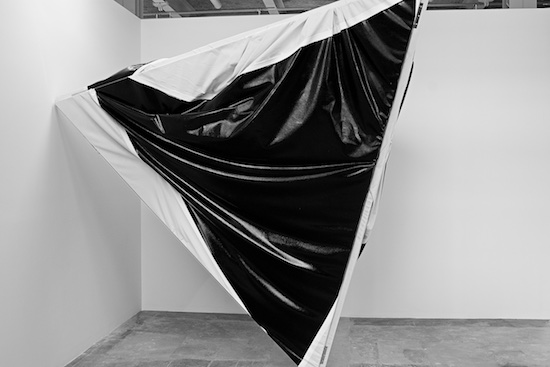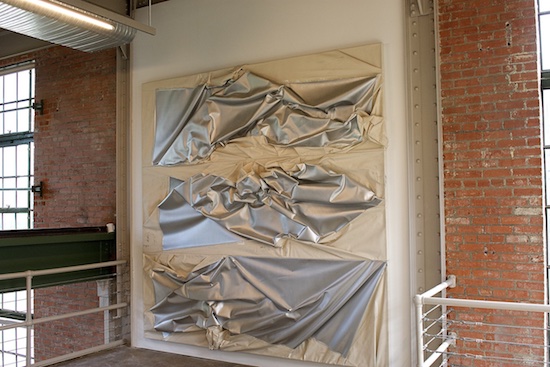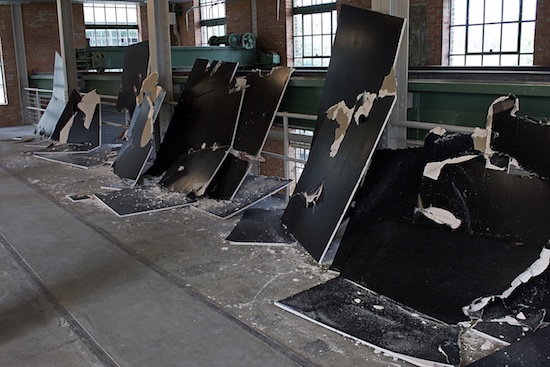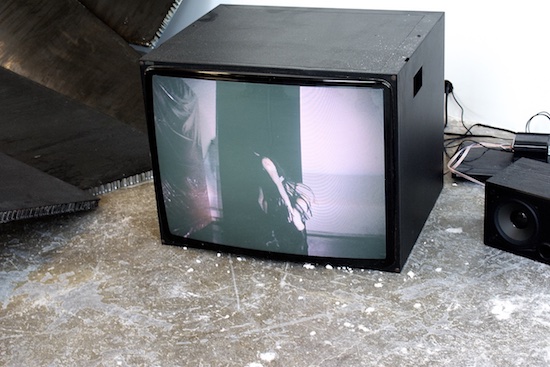After artist Steven Parrino’s death in a motorcycle accident in 2005 and his subsequent inclusion in the Whitney Biennial, his market prices briefly soared. But, as Bob Nickas noted in a 2011 piece for The Art Newspaper, Parrino’s painting failed to sell at all at a 2010 auction and his prices have fallen off since then. Just like those earliest New York punk and no wave bands, it seems that the Parrino estate is doomed to cult iconic status: endlessly adored by those in the know, but utterly elusive of capital gains.
Perhaps because of this, Parrino’s work provides considerable conceptual opportunities to risk-taking curators. Parrino’s current exhibition at The Dallas Power Station, a non-profit contemporary art space in a former Dallas Power & Light building, proves this notion with its unique interplay between the deconstructed nature of Parrino’s work and the decidedly industrial nature of the exhibition space.
Steve Parrino was, in many ways, the defining “punk rock artist.” Like other fine artists of the time (Robert Longo played in Rhys Chatham’s guitar army in the late-‘70s, Basquiat played in a noise band called Grey with a young and annoyingly handsome Vincent Gallo), the late Parrino was part of New York’s late-70s punk multimedia culture and played in several noise and punk bands, most notably the duo Electrophilia with the painter and keyboardist Jutta Koether.
As was often the case for artists, musicians, filmmakers, and poets working in New York during that era, punk culture had a powerful effect on Parrino’s psyche and artistic process and you can see that on the surface of all of his artworks. In fact, his artistic output seems to visualize the ideas that were sonically explored by bands like Mars, DNA, The Contorions, The Voidoids, and others. Just as the early punks and no wavers worked with formalist pop and rock music conventions only to exploit, destroy, or subvert them; Parrino worked within the formalist conventions of art-making (monochrome paintings, modernism, action painting) and then utterly tore those conventions apart with his belief that “radicalism comes from content” and not necessarily from form.
Punk rock and no wave were not all-together radically new forms of music. Even something as seemingly extreme as Teenage Jesus and the Jerks worked with guitar riffs and other Chuck Berry-isms. But Lydia Lunch and others were able to find something drastically new by tearing those conventions apart at the seams. Parrino, like those early punks did with rock music, referenced earlier forms of art-making, but also fearlessly sought the new. He destroyed conventions literally with his monochromatic paintings by often tearing, slashing, and otherwise destroying the canvases that he worked on. He was also fascinated with new media, like photo collage, and he was a pioneer in video art.

True to his outsider nature, Parrino’s artistic output is often caught between two dominant strains of 1980s postmodernism. In his paintings, Parrino was often tagged with the Neo-Geo label that was also used to describe the works of the Swiss post-Fluxus painter and performance artist John Armleder and American dayglo geometric painter Peter Halley. Neo-Geo typically describes artists that used modern abstraction with cynical references to pop-culture and music. But Parrino’s work in collage and video departed from the Neo-Geo label; his videos and collages read as dissections and deconstructions of mass media imagery and put him more in line with artists of the “Pictures Generation” (Cindy Sherman, Richard Prince, Laurie Simmons, etc.). From a critical standpoint, this makes examination of Parrino’s output thrilling and encompassing. However, from a market standpoint, Parrino has always had trouble selling in comparison with his wildly successful contemporaries.
Though it might be shocking considering the sizable influence Parrino has had on contemporary art, this exhibition at The Dallas Power Station, entitled Dancing on Graves and housed in an abandoned warehouse, is the first institutional survey Parrino’s work has ever received in America. While that might feel criminal to Parrino admirers, it’s also perfectly appropriate that the artist who was too formal for punk and too punk for the formalists be celebrated by a Dallas art community that exists well outside the New York-London-Paris nexus and within the confines of a space that blatantly flouts the conventions of the white cube.

The exhibition takes its title from a video piece shot by Parrino in 1999. The video features a leather-clad woman dancing upon a platform of black-enamel aluminum. She then looks to the lens, turns around, and bends over in a porn-esque provocative pose. A wall of distortion grows audible off camera, and the dancer’s body forms a V. We then see Parrino cutting into a piece of aluminum. The video works as a metaphor for Parrino’s larger art practice. Parrino claimed to have “necrophilliac feelings for painting,” in that while he believed it was dead, that there was still strong work to be done in the aftermath of its demise. The woman in the video is sex, or life, or painting towards the end of its relevance. Then the camera cuts, and Parrino is finding new life for the dead medium in his destruction of the aluminium.
The video sets the pace for the exhibition ideologically as it charts Parrino’s ability to pay homage to his heroes (from Yves Klein to Warhol) while always demanding that art objects – and paintings specifically – could and should be more (“if painting is dead anyways, what was the point of adhering to painterly tradition?” suggests Parrino’s work). If you told Parrino that paintings were supposed to be flat, for instance, he would make a piece like Untitled (2004). The piece resembles a black pyramid, with three points angled towards the gallery’s walls and floors and its tip pointed towards the infinite sky. It works as a painting and as a three-dimensional structure suggesting infinite space in its form and positioning.

13 Shattered Panels (for Joey Ramone), made in memoriam of Parrino’s Ramones fronting friend, is exactly that: 13 monochromatic panels shattered, beaten, and destroyed (in fact, Power Station gallery manager Gregory Ruppe has taken delight in furthering the destruction of the panels with a baseball bat). How do you create art out of a dead medium? Just as Lydia Lunch and later noise rock bands like Harry Pussy did with rock instrumentation, Parrino found something new and exciting in the demolition of irrelevant techniques. Parrino’s work can give birth to a peculiar but exciting beauty from the rubble of a no-longer-relevant artistic medium.
The Power Station is an interesting location to hold the artist’s first American institutional survey. To some of us, Parrino reads as the ultimate New York punk artist, but nevertheless, the New York art world is one guided by academic norms and institutional gatekeepers. Parrino’s work defies easy categorization, to say the least. The success afforded to friends, like the great Cady Nolan, eluded him in life and it seems like it will continue to elude him in death.
But away from the hoopla of New York and all its capitalist necessities, in this odd venue that structurally feels perfectly in line with Parrino’s conceptual ideologies (Dallas Power Station reminds one of the kind of venue where noise festivals are held), one realizes that true punk/no wave ideologies should always remain outside of the mainstream art world. And I don’t want to suggest that Parrino’s estate exists solely outside of the art market (Larry Gagosian was his dealer for chrissakes’), but Parrino’s determination to never be pigeonholed as either a punk artist or a formalist has absolutely resulted in his work not achieving the market value of Prince or Longo or Halley. Parrino’s estate may never have the kind of monetary value attached to it that it deserves, but from a conceptual curatorial standpoint, every work of art that the man made is pure gold.
Steven Parrino, Dancing on Graves, is at the Power Station, Dallas, until 16 June


